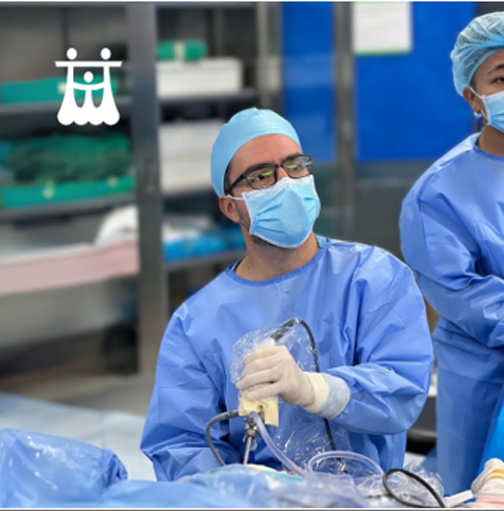 Life & Style
Life & Style

Dr. Andres Sosa*
Knee injuries are quite common, especially among those who are active in sports or travel frequently and the meniscus is one of the most critical issues affecting the knee.
Traditionally, meniscal tears were treated with meniscectomy, where the damaged meniscus was removed.
However, modern orthopaedic practices have increasingly favoured meniscus repair, offering superior outcomes for patients.
The meniscus is a piece of cartilage in the knee that cushions and stabilises the joint. It acts as a shock absorber, protecting the bones from wear and tear. Each of your knees has two pieces of this cartilage, the medial meniscus is on the inside of the knee.
Symptoms of meniscal injury
Meniscal tears often present with a range of symptoms, including:
Pain: This is usually localised to the knee joint line.
Swelling: The knee may swell, especially in the first 24 hours post-injury.
Stiffness: A feeling of tightness or restricted movement.
Locking or catching: Sensation of the knee getting stuck or catching during movement.
Decreased range of motion: Difficulty bending or straightening the knee fully.
 |
| A thorough physical examination is crucial for diagnosing meniscal injuries. — Photos courtesy of the Family Medical Practice |
Common causes
Meniscal injuries can occur due to various mechanisms.
Sports activities: Sudden twists or turns, often seen in sports like football, basketball or skiing.
Accidents: Trauma from falls or collisions.
Degenerative changes: With age, the meniscus can weaken and tear due to normal wear and tear, even with minimal stress.
Weight: With some extra kilos, our knee has to deal with more load, increasing the risk of meniscal ruptures.
Physical examination and diagnostics
A thorough physical examination is crucial for diagnosing meniscal injuries. Your orthopaedic specialist will assess:
Tenderness: Pressing on the knee to locate pain.
Range of motion: Evaluating the flexibility and movement of the knee.
Special tests: Such as the McMurray test, which can reveal meniscal tears.
For accurate diagnosis, imaging studies are employed:
Ultrasound: Helps assess the meniscus and surrounding structures for fluid accumulation or tears.
MRI (Magnetic Resonance Imaging): Provides a detailed view of the meniscus and is highly effective in identifying meniscal tears and assessing if it needs a surgical intervention.
Treatment
Not all meniscal injuries need surgery. If a tear occurs on the outside of the meniscus, it is more likely to be able to heal without surgery, because good blood flow to this part of the tissue can help the cartilage to repair itself. A tear on the inside of the meniscus, however, does not have this same blood flow to promote healing and may require surgery.
Advantages of repair
Repairing the meniscus has become the preferred method as it offers significant advantages:
The procedure
Meniscus repair is performed using arthroscopic surgery, where only a tiny incision is made in the knee. This reduces the risk of infection and typically results in less postoperative pain and swelling. Patients can often return to daily activities too, although post-surgery physiotherapy plays a crucial role in the recovery process.
Aftercare following surgery
Physiotherapy can be needed to gradually improve knee movement and flexibility and strengthen the muscles to support the joint, thereby also reducing the risk of future injuries.
Returning to sports and other high-impact activities should be done progressively to ensure a full recovery. In the beginning it is recommended to focus on low-impact activities such as swimming or cycling to maintain fitness without stressing the knee. The patient may follow a rehabilitation program to then fully return to your sport.
Choosing the right orthopaedic care in Hà Nội
For expatriates, diplomats, and tourists in Hà Nội, choosing an orthopaedic specialist experienced in meniscus repair is crucial. Our orthopaedic team is a pioneer in meniscal repair techniques in Việt Nam, offering state-of-the-art arthroscopic procedures and personalised rehabilitation programmes.
Meniscus repair is not just a treatment. It is a pathway to a healthier and more active life. By opting for repair over removal, you invest in long-term knee health and overall wellbeing. FAMILY MEDICAL PRACTICE
 |
| Dr. Andres Sosa. — Photo courtesy of FMP |
*Dr. Andres Sosa is our orthopaedic surgeon specialising in sports medicine and trauma. After his residency in Orthopaedics, he took a Master’s in Upper Limb Surgery at the University of Bologna (Italy). attended the Sports Medicine program at Thomas Jefferson University in Philadelphia (USA) and obtained his second master’s in Shoulder Surgery with the University of Andalucía (Spain). Once in Việt Nam, he continues his surgical training with Arthrex ArthroLab (Singapore) focused on arthroscopic techniques for shoulder and knee injuries. Dr. Sosa joined FMP in 2018 and is responsible for all orthopaedic and trauma cases. He is also a sports nutrition expert from Major University (Chile) and is fluent in English, Italian and Spanish.
FMP Healthcare Group operates medical centres in major cities including HCM City, Hà Nội, and Đà Nẵng, offering consultations with international doctors, check-up centres and emergency ambulance services.
Visit FMP Hà Nội 24/7 at 298I P. Kim Mã, Kim Mã, Ba Đình.
To book an appointment, please call (024).3843.0748, chat via Whatsapp, Viber or Zalo on +84.944.43.1919 or email hanoi@vietnammedicalpractice.com




